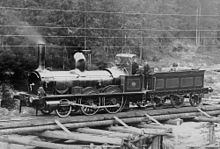History of the railway in Norway

The history of the railway in Norway is shaped by the difficult topography in large parts of the country for railway construction .
Geographical requirements
In the largely sparsely populated high mountain country of Norway with its fjord coast and its great distances, the construction of the railway network was associated with particular difficulties. Many of the long-distance transport certain Norwegian railway lines were in the 19th century, first in narrow gauge , mostly Cape gauge , running and in the 20th century to standard gauge umgespurt .
First track construction
The 68 km long Hovedbane between Christiania and Eidsvoll was the first railway line in Norway to go into operation in standard gauge in 1854 . In Eidsvoll there was a connection to the steamboat line established on Mjøsa .
From Hamar on Mjøsa to the north, the Hamar-Grundsetbane was built to Elverum in Kapspur in 1862 .
Kongsvingerbanen between Lillestrøm on the Hovedbane and Kongsvinger was opened in standard gauge in 1862 and was later connected eastward to the Swedish rail network.
In Central Norway, the Trondheim-Støren-Bane was opened in Kapspur in 1864 . With the gap to the Hamar – Grundsetbanen through the Rørosbane , the first steam-powered inland connection between Oslo and Trondheim was created in 1877 as a combination of full- gauge railway , inland waterway and narrow-gauge railway .
Bergensbanen began in 1875 with the section from Bergen (Norway) to Voss, completed in 1883, as a narrow-gauge railway. It was not until 20 years later, from 1902 to 1909, that the standard gauge line was connected to the rest of the railway network via the Hardangervidda . In 1905 the gauge of the old section was adjusted.
The western part of the Luleå – Narvik railway from Kiruna to the Norwegian port of Narvik , ( Norwegian Ofotbanen ) was completed in 1903. The 15c 125 locomotive ordered for the Hell – Sunnanbanen was delivered directly from the factory to the Ofotbane in February 1902. As a loan from NSB District 4 in Trondheim, she drove the Norwegian train to celebrate the unification of the Norwegian and Swedish parts of the Kiruna – Narvik – Fagernes route on November 15, 1902, to Riksgrensen .
Line structures in the 20th century
Several important railway lines in Norway were only started and completed in the 20th century:
- from 1913 to 1921 the Dovre Railway , which considerably shortened travel times between Oslo and Trondheim
- from 1912 to 1924 the Raumabane to Åndalsnes harbor
- from 1920 to 1944 the Sørlandsbane in southern Norway
- The construction of the Nordlandsbane was carried out in many individual sections from 1905 (Trondheim– Steinkjer ) to 1962 ( Bodø at the Arctic Circle)
Norwegian State Railways
The founding of the Norwegian State Railways was decided by Storting in 1882 . From 1883, the joint venture brought together all the state railways that had opened since 1861 under one central administration. Lorentz Henrik Müller Segelcke became the first general director. Before 1883, the state had built and operated railways as independent public limited companies with state majority holdings. These were kept locally and had names that were based on geographical terms. The Vestbanerne , which comprised the three narrow-gauge railways Randsfjordbanen , Christiania – Drammenbanen (CDB) and Vestfoldbanen , should serve as an example .
In 1996 the Norges Statsbaner (NSB) were divided into the Jernbaneverket (JBV), which is responsible for the infrastructure, and the Norges Statsbaner AB (NSB AB) , which mainly operated the passenger traffic. In 2002 this was transferred to the public limited company Norges Statsbaner AS , which is owned by the state. The freight traffic was taken over by several other companies.
Web links
- Kort om norsk jernbane history. norsk-jernbanemuseum.no, accessed November 12, 2014 (Norwegian).
- Railway map 1912
Individual evidence
- ↑ NSB steam locomotive type 15c. gamlenarvik.no, accessed February 21, 2014 (Norwegian).